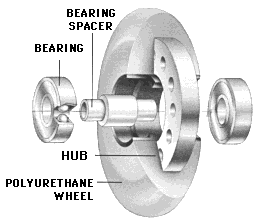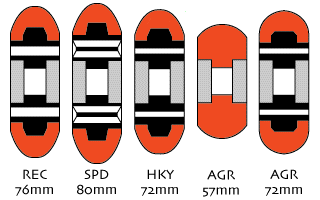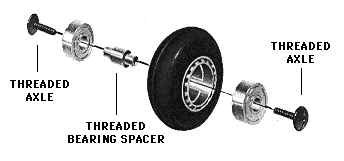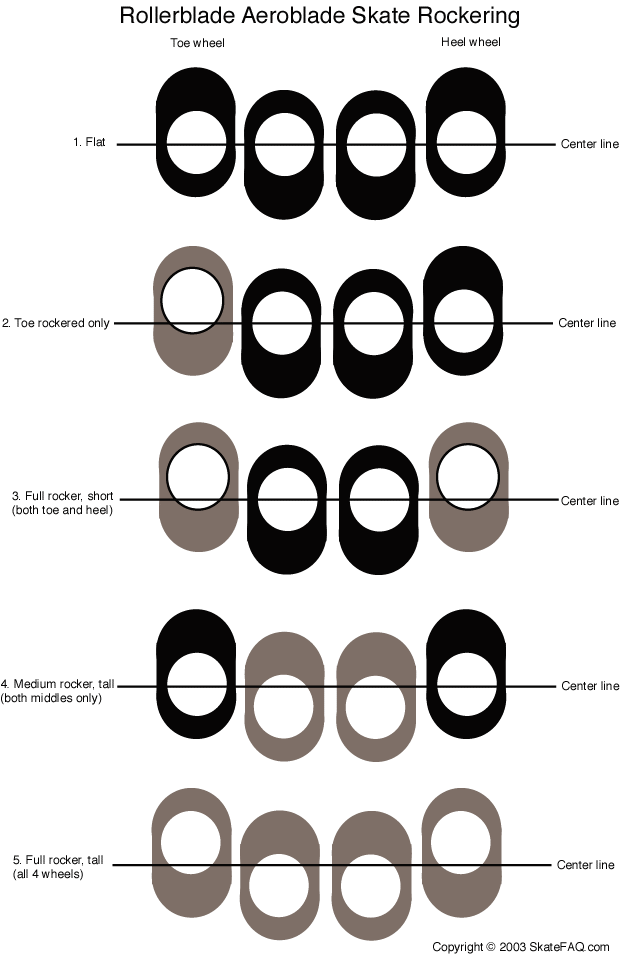Table of Contents
Inline Wheels Files
(written May 17, 1992)
(last changed June 11, 1995)
Copyright © 1992-2005 Anthony D. Chen, All Rights Reserved
Technical Info
Most standard inline wheels are made mainly of polyurethane. Some wheels are designed for sliding and use use a mix of different durometers (like the RollerEdge wheels), or plastic rings (like the BrakeWheel). Wheels are classified on diameter, hardness, rebound, profile and core. Some are even classified by weight. However, most often you will see only the diameter and hardness printed on the wheels (e.g. 76mm 78A or 70mm 82A, etc.). The profile and core you can tell by visual inspection.

Figure 1. Exploded View of Inline Skate Wheel
Diameter
The diameter of the wheel means simply how tall the wheel is. The usual diameters range from 43mm to 80mm. Most common sizes you'll come across for recreational skating are 72 and 76mm. Skaters wanting speed tend to use 80mm wheels, although 76mm's are used too, depending on the skates and racing course and distance. Vert/ramp skaters use short wheels with a high durometer to do rail slides. These range from 43 to 76mm, depending on the skating situation (vert, ramp, rails, etc.).i
Generally, racing skates will fit up to 80mm wheels, high-end skates up to 77mm (sometimes 80 now), and the rest of the models up to 72mm. Although these are the designated max-sizes, skates can often take slightly taller wheels than the official specifications. For instance, in the old Bauer XF/3's, with the front and heel wheel spacers moved in (for a shortened wheelbase), can use 76mm wheels for all four positions. Extension modification (i.e., scraping down) of skates are need for wheels much larger than the intended size.
In general, taller wheels will let you cruise faster but take longer to spin up. Taller wheels also tend to be less manueverable than shorter wheels. Shorter wheels are cheaper, but in general don't last as long since they have less material to wear down overall, given the same durometer. However since many of the small wheels are for stunts, they all tend to be sold in higher durometers anyway (they slide better), so they won't necessarily wear out that quickly.
70mm 72mm 76mm 80mm Average speed ____________________________________________ Fast Quick Turns ______________________________________ Slower Turns
Durometer (hardness)
Durometer is a relative hardness measure frequently used for rubber and plastic products. There are several scales, with the "A" scale (hence the 78A, etc.) used for wheels. The number is the rating from 0-100, with 0 being no resistance and 100 being very hard plastic.
Note: there is a Rockwell scale which is used for steel. Only one wheel uses it (as of the time of this writing), the Pebbles by Kryptonics, with a rating of 50R.
Recreational wheels generally run from 74A to 82A. For outdoors, the softer the wheel, the better the shock absorption. The trade-off is that softer wheels wear out faster. Harder wheels, since they have less drag, are preferred on indoor surfaces which are usually very smooth (e.g. hockey).
Some skaters vary their wheel durometer depending on the temperature outside. Cold weather will mean the ground is harder so soft wheels are more suitable. In really warm weather the road might start literally melting, in which case a high durometer setup would be more preferrable.
74A 78A 82A 85A Average Wear_________________________________Longest Wear High Grip____________________________________Average Grip High Rebound______________________________Average Rebound Low Body Weight__________________________High Body Weight Smooth Ride_____________________________________Hard Ride
Rebound
A higher rebound will provide more response on each stroke. The only reference to a rebound scale in the inline industry now is the Bashore Rebound, used by Roller Edge. Otherwise, rebound is referred to as low, medium or high. The rebound labeling seems to have been phased out as not many people seem to compare wheels based on this feature.
Profile
The profile of a wheel is defined by the cross-section of the wheel where it meets the ground. All wheels are 24mm thick as an industry standard, but the variation in a wheel's "footprint" is what provides different functionality. The larger the footprint, the greater the traction and stability. Many made-for-hockey wheels tend to have a wide footprint for those sharp turns. Racing wheels on the other hand, tend to be more tapered near the edges. More recently, FR Progressors has developed an asymmetrically-profiled wheel, to help align on curbs or rails.
Wide/fat Normal profile Narrow (race) Best Cornering___________________________________Less Stable Slow____________________________________________________Fast

Figure 2. Example wheel profiles
Hubs/Cores
The hubs or cores (the terms are used somewhat interchangeably) are very important to the overall performance of the wheel. The core is everything other than the wheel material. The core holds the bearings and connects to the wheel material. Some wheels are open core (spokes showing), closed core (spokes covered), or no cores (real small wheels don't really need cores.) If the bearing core is slightly too large (as it often is for shoddy wheels), it will not hold the bearings tightly enough. This can allow the wheel to become "cocked" so that it rubs against the frame. Only one wheel needs to be out of alignment to mess things up.
Misalignment is a serious problem, not only because it causes drag, but because it heats up the wheel. This will soon cause it to seperate from the hub and expand, and eventually destroy the wheel.
The first sign is that the wheels creak as you switch your weight on the skate. If you remove the wheel from the frame, you can see an arc clear of dirt and dust where the wheel was rubbing. If you notice this, put your hands on your wheels after a long fast skate and see if any of them are much warmer than the others. If so, they are probably rubbing.
This can happen a lot easier on frames like the Mogema and the Darkstar that have very close tolerences and the side of the frame is close to the side of the wheel. I'm not sure if is as big as a problem (or a problem at all) for recreational skates like the Aeroblade. The creaking is bothersome in any event.
Closed Core Tri Spoke Core Racing Core High Wheel Weight_________________________________Low Wheel Weight Longest Wear__________________________________________Average Wear
The standard hub is also called a "608" hub, which means it holds a 608-type bearing (which is most all bearings on the market today). See the Bearings FAQs for more on that. Basically the digits denote the size of the bearing's inner and outer diameters.
More recently, some skaters have started using micro-bearings (sized "688") and micro-hub wheels, to help keep the weight of the wheels down. The wheel weight reduction is supposedly about 20% on the wheels and 70% on the bearings.
Axle Kits
Another important aspect of your wheels is the axles. There are several axle replacement/upgrade kits (such as the Hyper Hop-up Kit and the Blading Edge Kit) designed to let your wheels roll much faster than your stock axles will allow. These kits are usually made of aluminium or steel. What they consist of is two axle bolts per wheel, each screwing into the threaded spacer in the wheel (the part that is sandwiched between the bearings). This prevents overtightening, which is common with regular axle systems, and will allow your wheels/bearings to spin freely. When putting your wheels back, make sure the wheels are just snug enough so they don't move around. Anything more just increases the friction on your bearings.

Figure 3. Exploded view of an Axle Kit
Wheel Rotation Maintenance
Wheels of any durometer will wear out, given enough mileage. There's only so much polyurethane on your wheels, while there's thousands of miles of asphalt out there. Much less wearage occurs for indoor skating, however.
In general, your wheels are due for maintenance when your skates are much slower and not rolling as smoothly as when new. The inside edges will wear more quickly, which you will eventually notice:

Figure 4. Front view of a worn inline skating wheel
For those of you without the benefit of a graphics-ready computer:
........................................................ ........|....|.........................|....|........... inside..|....|..outside.......inside...\....|...outside. .edge...|....|....edge.........edge.....\...|.....edge.. ........\____/...........................\__/........... ........................................................ .......new.wheel.......................worn.wheel....... ........................................................
There are two things you can do to get the most use from your wheels: rotate and flip. Rotating your wheels means to switch the positions of the wheels. Different positions (like the heel or toe wheels) receive varying amounts of wear. By rotating the wheels, you can even out the wear on each wheel.
Flipping your wheels means to turn each wheel so that the worn edge now faces the outside. This lets you wear down the other side of the wheels.
There are several patterns for wheel rotation. The one you use isn't crucial, since there's no "magic" rotation formula that works for all situations. The main point is to maintain an even wear on your wheels. Often times you may find yourself swapping wheels at random until you get a good wearage distribution on your skates.
Some common rotation patterns:
The front wheel is "1" and the back wheel is either "4" or "5".
| 3-wheel skates: | 3->2, 2->1, 1->3 |
| 4-wheel skates: | 4<->2, 3<->1 OR 4->3 3->2 2->1 1->4 |
| 5-wheel skates: | 5->3, 4->2, 3->1, 2->5, 1->4 OR 5->3, 4->5, 3->2, 2->4 |
While you're rotating and flipping your wheels, you might as well wipe off your skates, rails, wheels and bearings with a damp cloth. Some people wipe down their skates everytime they go out, even if they don't do any rotation, but I recommend you do it at least everytime you rotate your wheels. This keeps the amount of dirt on your skates and wheels to a minimum, which helps keeps grit out of your bearings.
Rockering Your Skates
Having skates non-rockered means the axles and wheels are all at the same height. This is the way most recreational skates come when new. Skates for racing, aggressive skating, and hockey may come with configurations tailored to those styles of skating. What many skates allow you to do is to change the height of some or all of the axles, to provide a different "blade" to skate on. Rockered skates then, have the middle two wheels lower relative to the front and heel wheels. This is accomplished by having oval spacers with an offset axle-hole; each spacer can have an up or down position.
Racing skates are also adjustable, but only in the horizontal direction, allowing for a longer or shorter wheelbase.
Although subject to some disagreement, many skaters find rockering provides much more maneuverability due to the curved "blade" of the wheels. Whether you rocker or not is really up to you. Many hockey players prefer to have their skates rockered for sharper turns on the court, while racers keep their blades flat for more stability at high speeds (rockers at high speed will produce speed wobble). Artisitic skaters may also prefer rockered, while extreme skaters may opt to keep them flat.
Depending on your skates, there are various rockering configurations possible. If your skates can adjust the height of only the middle two wheels, you can have your skates flat or rockered:
Flat : ==frame==
1 2 3 4
Rockered: ==frame==
1 4
2 3
If your skates can adjust the height of all four wheels then you have
the positions of
short even rocker: ==frame== (wheels closer to boot, for more
control)
1 4
2 3
tall even rocker: ==frame== (taller, for sharper turns)
1 4
2 3
front-lift rocker: ==frame== (a little more stable than regular
rocker)
1
2 3 4
front-lift, : ==frame== (tilts skates forward)
rear-down, rocker 1
2 3
4
Below is a nicer diagram of the variety of rockering available, if you have all 4 wheel spacers rockerable, such as on the Rollerblade Aeroblades (my first and only non-racing skates). Hopefully it's obvious, but in case anyone is confused, the ovals below are not the wheels, but the spacers that go between the frame and the bearings. Each spacer has the axle hole offset, to allow for each wheel to be at two different heights.

Figure 5: Wheel rockering options
As you will notice, the way Rollerblade designed this skate (way back around 1991 or so) you can achieve a large variety of rockering combinations. The diagram is probably not 100% to scale, but I tried to draw it somewhat close to reality.
Note that the toe and heel positions are such that their lowest orientation is the same level as the highest orientation of the middle two wheels (combination 1). This is so that you can rocker just the toe and/or heel (combination 2 or 3) if you want to keep your skates at the same height. The vertical change from rockering is roughly 2mm in height for the given wheel position. So this "short" rocker combination gives you a 2mm spread between the heights of the wheels. The middle wheels stay on the ground at the same height as before.
You can also achieve the same 2mm spread, by rockering only the two middle wheels (combination 4). The difference between this combinations 2 or 3 is that, while the relative positions of the wheels are the same, your overall height has increased slighty (by 2mm) due to the middle wheels being lower relative to the frame.
Of course, you can combine the two approaches and gain an even larger rocker effect, by raising the toe and heel plus lowering the middle two wheels. This would be combinations 3 + 4 = combination 5. Your overall height spread then would be 2mm + 2mm = 4mm.
There are other combinations that I didn't draw, but the ones above would be the more common ones.
Now it's important to note that all of the previous rockering discussion was based on the assumption that all your wheels are of the same size (i.e., height). There's nothing that says you can't use wheels of differing heights to achieve the same rockering effect.
Also, there are lots of examples of mixed wheel sizes in the racing and aggressive skating fields. These aren't really rockering configurations but they're still nice examples of what you can do with mixed wheel sizes. On the racing front, some frames are now designed such that the axles are at different heights to allow large 100mm wheels at front and back and a smaller 80mm wheel under the toe portion of the boot. An example is the Xenan racing frames:
New wheels can run from around $2.00 to $10.00, depending on the 5 criteria referred to at the beginning of this section. There are many inline wheel manufacturers out there: Hyper, Kryptonics, FR Progressors, Senate, Labeda, UFO, Cyko, Cozmo, Grizzly Gear, Kuzak, RollerEdge, BrakerWheel, Ultimate, Bullzeye, Chaos, Core, Heavy, Kopp, Square, Sims and probably several others.
To save money on wheels, shop for "blems" (blemished) wheels that many skate stores (including online stores) sell. Blems are perfectly good wheels except they have cosmetic defects. They typically sell for $1 - $1.50 or even less maybe. As with lots of "remaindered" products, blem wheels may not always be readily available all the time, so if you find a good blems deal, and you need wheels, go for it.
Unless you need specific wheels (racing or aggressive), for most recreational skating, there's no reason you can't do with blems if they are of the right type for you. Believe me, with brand new wheels, after a bit of skating, they're going to look somewhat indistinguishable from the blems anyway 8-)
Hop-up Kits
Hop-up kits are simply upgrade kits that include frame spacers, bearing spacers, and axels. They're made of aluminium or brass or some other metal. Some incorporate threaded spacers too. The advantage in using hop-up kits is that you can crank down real hard on your bolts without compressing the spacers. The stock plastic spacers on most skates will compress or even crack if you do this a lot. (more to come in this section)
If you want, look at the hop-up kit reviews in section 3.4.
*All images copyrighted © 1992-2005 by Anthony D. Chen. Permission is granted to use this logo in World Wide Web HTML files so long as this copyright notice is included as either an HTML comment alongside the invokation (IMG SRC or HREF or otherwise) of the logo, or in the visible text.
The image may not be sold for profit, nor incorporated in commercial documents or merchandise without prior written permission of the copyright holder.



